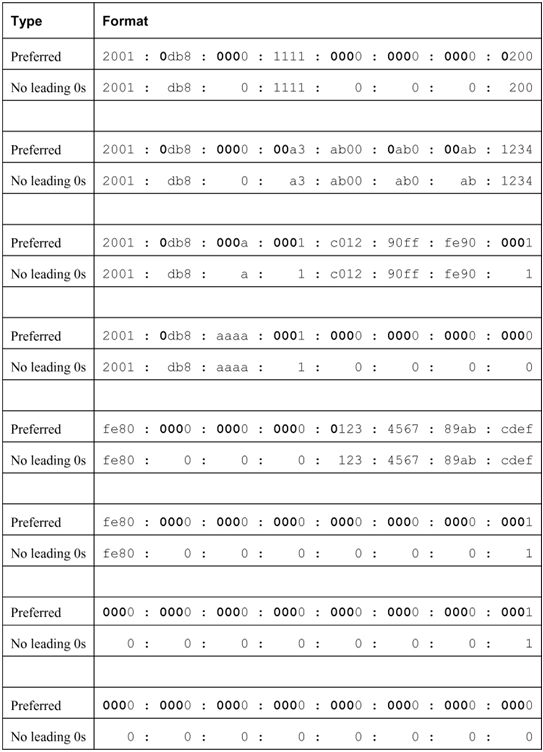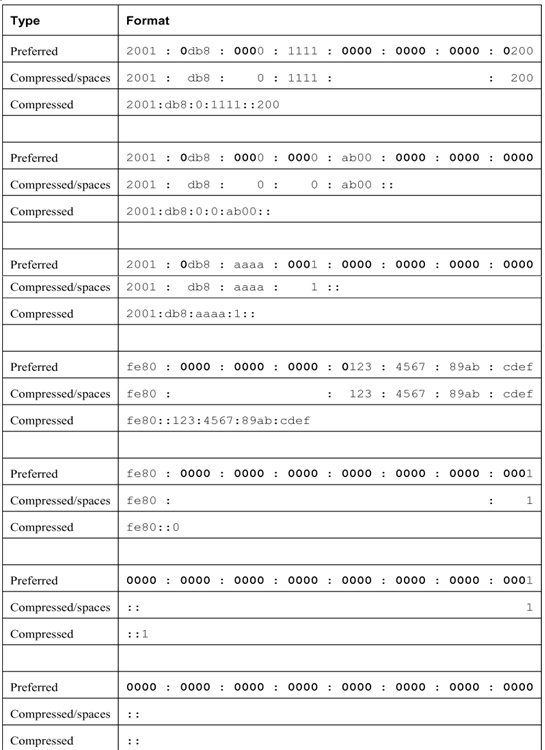The previous figure also shows that the preferred format for writing an IPv6 address is x:x:x:x:x:x:x:x, with each “x” consisting of four hexadecimal values. The term octet refers to the eight bits of an IPv4 address. In IPv6, a hextet is the unofficial term used to refer to a segment of 16 bits, or four hexadecimal values. Each “x” is a single hextet which is 16 bits or four hexadecimal digits.
Preferred format means that you write IPv6 address using all 32 hexadecimal digits. It does not necessarily mean that it is the ideal method for representing the IPv6 address. In this module, you will see two rules that help to reduce the number of digits needed to represent an IPv6 address.
Several IPv6 addresses in the preferred format as shown in Example 10-1
Example 10-1 IPv6 Address Preferred Format
2001 : 0db8 : 0000 : 1111 : 0000 : 0000 : 0000: 0200
2001 : 0db8 : 0000 : 00a3 : abcd : 0000 : 0000: 1234
2001 : 0db8 : 000a : 0001 : c012 : 9aff : fe9a: 19ac
2001 : 0db8 : aaaa : 0001 : 0000 : 0000 : 0000: 0000
fe80 : 0000 : 0000 : 0000 : 0123 : 4567 : 89ab: cdef
fe80 : 0000 : 0000 : 0000 : 0000 : 0000 : 0000: 0001
fe80 : 0000 : 0000 : 0000 : c012 : 9aff : fe9a: 19ac
fe80 : 0000 : 0000 : 0000 : 0123 : 4567 : 89ab: cdef
0000 : 0000 : 0000 : 0000 : 0000 : 0000 : 0000: 0001
0000 : 0000 : 0000 : 0000 : 0000 : 0000 : 0000: 0000
Video – IPv6 Formatting Rules (10.2.3)
Refer to the online course to view this video.
Rule 1 — Omit Leading Zeros (10.2.4)
The first rule to help reduce the notation of IPv6 addresses is to omit any leading 0s (zeros) in any hextet. Here are four examples of ways to omit leading zeros:
• 01ab can be represented as 1ab
• 09f0 can be represented as 9f0
• 0a00 can be represented as a00
• 00ab can be represented as ab
This rule only applies to leading 0s, NOT to trailing 0s, otherwise the address would be ambiguous. For example, the hextet “abc” could be either “0abc” or “abc0”, but these do not represent the same value. Table 10-1 shows examples of omitting leading 0s.

Table 10-1 Omitting Leading 0s
The second rule to help reduce the notation of IPv6 addresses is that a double colon (::) can replace any single, contiguous string of one or more 16-bit hextets consisting of all zeros. For example, 2001:db8:cafe:1:0:0:0:1 (leading 0s omitted) could be represented as 2001:db8:cafe:1::1. The double colon (::) is used in place of the three all-0 hextets (0:0:0).
The double colon (::) can only be used once within an address, otherwise there would be more than one possible resulting address. When used with the omitting leading 0s technique, the notation of IPv6 address can often be greatly reduced. This is commonly known as the compressed format.
Here is an example of the incorrect use of the double colon: 2001:db8::abcd::1234.
The double colon is used twice in the example above. Here are the possible expansions of this incorrect compressed format address:
• 2001:db8::abcd:0000:0000:1234
• 2001:db8::abcd:0000:0000:0000:1234
• 2001:db8:0000:abcd::1234
• 2001:db8:0000:0000:abcd::1234
If an address has more than one contiguous string of all-0 hextets, best practice is to use the double colon (::) on the longest string. If the strings are equal, the first string should use the double colon (::). Table 10-2 shows examples of omitting leading 0s and all 0 segments.

Table 10-2 Omitting Leading 0s and All 0 Segments
Activity – IPv6 Address Representations (10.2.6)
Refer to the online course to complete this Activity.
